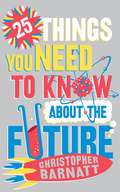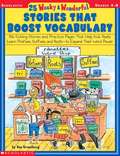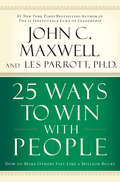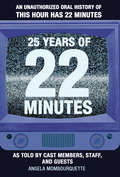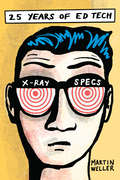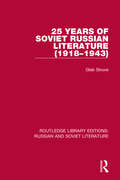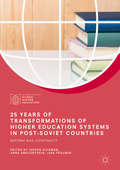- Table View
- List View
25 Things You Need to Know About the Future
by Christopher BarnattThe essential book for understanding the challenges and technologies that will shape the next few decadesHow will we live in the future? And what will the human race become? Will we nurture designer babies, be served by intelligent robots, have personal 3D printers, and grow products on the vine using synthetic biology? Or will shortages of oil, fresh water and other natural resources constrain our lifestyles and lead to industrial decline?In this fascinating guide, futurist Christopher Barnatt examines 25 known challenges and technologies that will help shape the next few decades. From Peak Water to vertical farms, nanotechnology to augmented reality, and electric cars to space travel, a startling picture is painted of future possibilities that no individual or business will be able to ignore.Highlighting life-changing research and innovation from over 250 companies, universities and non-profit organizations around the globe, 25 Things You Need to Know About the Future is a startling, frightening and powerful blueprint for anybody who wants to future gaze or future shape.
25 Things You Need to Know About the Future
by Christopher BarnattThe essential book for understanding the challenges and technologies that will shape the next few decadesHow will we live in the future? And what will the human race become? Will we nurture designer babies, be served by intelligent robots, have personal 3D printers, and grow products on the vine using synthetic biology? Or will shortages of oil, fresh water and other natural resources constrain our lifestyles and lead to industrial decline?In this fascinating guide, futurist Christopher Barnatt examines 25 known challenges and technologies that will help shape the next few decades. From Peak Water to vertical farms, nanotechnology to augmented reality, and electric cars to space travel, a startling picture is painted of future possibilities that no individual or business will be able to ignore.Highlighting life-changing research and innovation from over 250 companies, universities and non-profit organizations around the globe, 25 Things You Need to Know About the Future is a startling, frightening and powerful blueprint for anybody who wants to future gaze or future shape.
25 Tough Question About Women and the Church: Answers from God's Word That Will Set Women Free
by J Lee GradyGo ahead... ask the tough questions! This is not a "safe" Christian book that tells women to sit quietly and obediently in the back of the church. For far too long the church has prevented women from answering God's call on their lives. It's time for a change! "I will not be satisfied until the church repents for its gender prejudice and then fully releases women to obey the call of God on their lives.” --J. Lee Grady
25 Tropical Houses in Indonesia
by Masano Kawana Amir Sidharta Amanda Eberhardt25 Tropical Houses in Indonesia offers a selection of the best contemporary architecture in the archipelago, ranging from a new type of urban shop house to dramatic and flamboyant buildings emerging from the countryside. Drawing on classical Indonesian aesthetics and conventions and blending these with dynamic, cutting-edge design ideas, modern architecture in Indonesia has become dramatically aligned with international concepts of space, incorporating stunning local elements and materials.
25 Tropical Houses in the Philippines
by Elizabeth Reyes A. Chester Ong25 Tropical Houses of the Philippines features top Filipino architects and designers with ideas that are stylish, contemporary, and show twenty-first century savvy. These distinctive homes showcase the best residential work by Filipino architects--outstanding works by 20 designers stepping beyond traditional conventions toward Asian fusion trends and international modernist architecture. The book offers a tour of stunning structures ranging from gracious pavilion-houses in elite subdivisions of Manila to elegant vacation homes of Batangas and Mindoro.
25 Truths About Demons and Spiritual Warfare: Uncover the Hidden Effects of Demonic Influence
by David Diga Hernandez25 Truths about Demons and Spiritual Warfare will help readers to uncover demonic influence in areas others might overlook or miss, with twenty-five specific truths that will lead them to a newfound spiritual freedom. The Bible makes it clear: we are in a battle, and we do not wrestle against flesh and blood. There is a real devil and real demons engaged in a very real war—with us. But we don&’t have to fear the enemy. His kingdom is built on shifting shadows—lies that can only stop us if we believe them. This book will expose how demons operate, how they gain access to our lives, and how we can defeat them.
25 Wacky and Wonderful Stories That Boost Vocabulary
by Dan GreenbergNo more ho-hum, forgettable vocabulary lessons! These reproducible, funny stories will grab your students' attention and help them remember the prefixes, suffixes, and roots they need to know so they can become better readers and writers. A great way to boost standardized test scores!
25 Ways to Sew Jelly Rolls, Layer Cakes & Charm Packs
by Brioni GreenbergCreate stunning modern quilts and quilted projects from jelly rolls, layer cakes and other pre-cuts fabric bundles. Featuring 25 small and large projects, each made from pre-cut bundles of fabric, including full sized bed quilts, bags and table runners. Be inspired by fabulous contemporary quilt designs using the most exciting fabric lines, and use up the leftovers to make quick and easy small quilted projects.
25 Ways to Win with People
by John C. MaxwellYou've read John Maxwell's best-selling Winning with People, and now you're ready for some specific action steps to build on the knowledge you gained. 25 Ways to Win With People has just what you need! This complementary companion to the full-sized book is ideal for a quick refresher course on interpersonal relationships. A small sampling of the twenty-five specific actions readers can take to build positive, healthy relationships includes: Complimenting People in Front of Others Creating a Memory and Visiting It Often Encouraging the Dreams of Others
25 Ways to Win with People: How to Make Others Feel Like a Million Bucks
by John C. Maxwell Leslie ParrottYou've read John Maxwell's best-selling Winning with People, and now you're ready for some specific action steps to build on the knowledge you gained. 25 Ways to Win With People has just what you need! This complementary companion to the full-sized book is ideal for a quick refresher course on interpersonal relationships. A small sampling of the twenty-five specific actions readers can take to build positive, healthy relationships includes: Complimenting People in Front of Others Creating a Memory and Visiting It Often Encouraging the Dreams of Others
25 Ways to a Happier Marriage
by Les Parrott Leslie ParrottA simple guide to helping couples find happiness in their marriage.
25 Women Who Dared to Compete (Daring Women)
by Rebecca StanboroughDiscover 25 women who challenged the stereotypes of what it means to play like a girl. These women worked to even the playing field and steppped up to score points for women all around the world.
25 Women Who Dared to Create (Daring Women)
by Rebecca StanboroughDiscover 25 women who designed their own futures. From dancers to musicians to artists, these women drew from their imaginations and dreamed of the impossible.
25 Women Who Dared to Go (Daring Women)
by Allison LassieurFrom the fearless to the feared, discover 25 women who dared. Dared to conquer their dreams, win wars, discover sights unseen, and more. Readers will learn about bold women who were determined to achieve something great in the face of adversity.
25 Women Who Defied Limitations (Daring Women)
by Emma Carlson Berne Emma BernayDiscover 25 women whose disabilities did not stand in the way of their great achievements. Each woman profiled in this collection faced the challenge of a disability while pursuing excellence in her field, including the arts, sciences, sports, and politics.
25 Women Who Fought Back (Daring Women)
by Jill ShermanDiscover 25 women who challenged the status quo and fought for what they believed in. From all corners of the world, these women show us that barriers are meant to be broken and obstacles can be overcome. Learn about some of the fierce women who persevered in the face of adversity to fight for what they thought was right.
25 Women Who Protected Their Country (Daring Women)
by Emma Carlson Berne Emma BernayDiscover 25 women who served in the military and accomplished great feats of strength and bravery. Whether through medicine, espionage, journalism, or combat, these 25 women show what it takes to be a hero.
25 Women Who Ruled (Daring Women)
by Rebecca StanboroughDiscover 25 women who shattered the glass ceiling, each in their own way. In politics, government, the business world, and more, these women show us that ambition, perseverance, and hard work go a long way.
25 Women Who Thought of it First (Daring Women)
by Jill ShermanDiscover 25 women who were trailblazers in science, technology, architecture, engineering, and more. Learn about some of the women who defied expectations and introduced the world to new ideas and creations big and small.
25 Women: Essays on Their Art
by Dave HickeyNewsweek calls him “exhilarating and deeply engaging.” Time Out New York calls him “smart, provocative, and a great writer.” Critic Peter Schjeldahl, meanwhile, simply calls him “My hero.” There’s no one in the art world quite like Dave Hickey—and a new book of his writing is an event. 25 Women will not disappoint. The book collects Hickey’s best and most important writing about female artists from the past twenty years. But this is far more than a compilation: Hickey has revised each essay, bringing them up to date and drawing out common themes. Written in Hickey’s trademark style—accessible, witty, and powerfully illuminating—25 Women analyzes the work of Joan Mitchell, Bridget Riley, Fiona Rae, Lynda Benglis, Karen Carson, and many others. Hickey discusses their work as work, bringing politics and gender into the discussion only where it seems warranted by the art itself. The resulting book is not only a deep engagement with some of the most influential and innovative contemporary artists, but also a reflection on the life and role of the critic: the decisions, judgments, politics, and ethics that critics negotiate throughout their careers in the art world. Always engaging, often controversial, and never dull, Dave Hickey is a writer who gets people excited—and talking—about art. 25 Women will thrill his many fans, and make him plenty of new ones.
25 Years of 22 Minutes: An Unauthorized Oral History of This Hour Has 22 Minutes, As Told by Cast Members, Staff, and Guests
by Angela Mombourquette&“A great read for anyone who is a fan of the long-running Canadian comedy series—or just TV comedy in general.&” —Brioux.tv The final chaotic season of Codco had just wrapped when Mary Walsh sat down at a Toronto bistro with George Anthony, then creative head of CBC TV&’s arts programming. She&’d been thinking about a news-based comedy show—did he think that would fly? He did. That was the early &‘90s. Twenty-five seasons later, hundreds of thousands of Canadians continue to tune in weekly to This Hour Has 22 Minutes for its unashamedly Canadian, biting satirical take on politics and power. 25 Years of 22 Minutes takes readers backstage to hear first-hand accounts of the show&’s key moments—in the words of the writers, producers and cast members who were there. Readers will have a front-row seat to the birth of the show—including a crisis that had producers scrambling in the very first episode—and offer an insider&’s take on the highs, the lows, and the daily grind behind the scenes at 22 Minutes. &“A book that stands as a shining testament to the many &‘behind-the scenes&’ figures who&’ve made the show tick for 25 years.&” —Halifax Examiner &“The book includes unvarnished accounts of cast rivalries, off-air pranks, fast food with prime ministers and satirical moments that influenced the real Canadian news cycle . . . an inside look at the people, characters and moments they&’ve come to know intimately through their screens.&” —Atlantic Books Today
25 Years of Ed Tech (Issues in Distance Education)
by Martin WellerIn this lively and approachable volume based on his popular blog series, Martin Weller demonstrates a rich history of innovation and effective implementation of ed tech across higher education. From Bulletin Board Systems to blockchain, Weller follows the trajectory of education by focusing each chapter on a technology, theory, or concept that has influenced each year since 1994. Calling for both caution and enthusiasm, Weller advocates for a critical and research-based approach to new technologies, particularly in light of disinformation, the impact of social media on politics, and data surveillance trends. A concise and necessary retrospective, this book will be valuable to educators, ed tech practitioners, and higher education administrators, as well as students.
25 Years of Limestone College Men's Lacrosse
by Ben Price Dr Walt GriffinOne of the most successful programs at any level of collegiate athletics, Limestone College lacrosse began its legacy in Gaffney, South Carolina, in 1990 and has since built a tradition and reputation unique to all others. The four-time NCAA Division II National Champions paved the way for the sport of lacrosse in the state of South Carolina, as well as much of the southern United States. The first southern program in the sport's history, Limestone quickly fought off the stigma that it would not be able to compete, becoming a top contender even in the program's infancy. Just 10 years after its inaugural season, the Saints broke through with the most coveted prize of all--a national championship. Since then, Limestone has added three more crowns and has appeared in the championship round 10 times. While the popularity of lacrosse continues to grow in South Carolina and the surrounding area, so too does Limestone's lore. The Saints continue to push forward and will forever remain innovators of the sport's heritage.
25 Years of Soviet Russian Literature (Routledge Library Editions: Russian and Soviet Literature #1)
by Gleb StruveThis book, first published in 1944, is a comprehensive survey of post-revolutionary Russian literature up to the early 1940s. A huge range of writers are examined, and the analysis is made in the knowledge of the sometimes considerable pressure brought by the Government on writers in Soviet Russia. Links are made by the author between the writers being assessed, as well as to the Russian writers that had come before them. As a wide-ranging analysis of Soviet literature, this book has rarely been bettered.
25 Years of Transformations of Higher Education Systems in Post-Soviet Countries: Reform And Continuity (Palgrave Studies in Global Higher Education)
by Isak Froumin Jeroen Huisman Anna SmolentsevaThis open access book is a result of the first ever study of the transformations of the higher education institutional landscape in fifteen former USSR countries after the dissolution of the Soviet Union in 1991. It explores how the single Soviet model that developed across the vast and diverse territory of the Soviet Union over several decades has evolved into fifteen unique national systems, systems that have responded to national and global developments while still bearing some traces of the past. <P><P>The book is distinctive as it presents a comprehensive analysis of the reforms and transformations in the region in the last 25 years; and it focuses on institutional landscape through the evolution of the institutional types established and developed in Pre-Soviet, Soviet and Post-Soviet time. It also embraces all fifteen countries of the former USSR, and provides a comparative analysis of transformations of institutional landscape across Post-Soviet systems. It will be highly relevant for students and researchers in the fields of higher education and and sociology, particularly those with an interest in historical and comparative studies.
